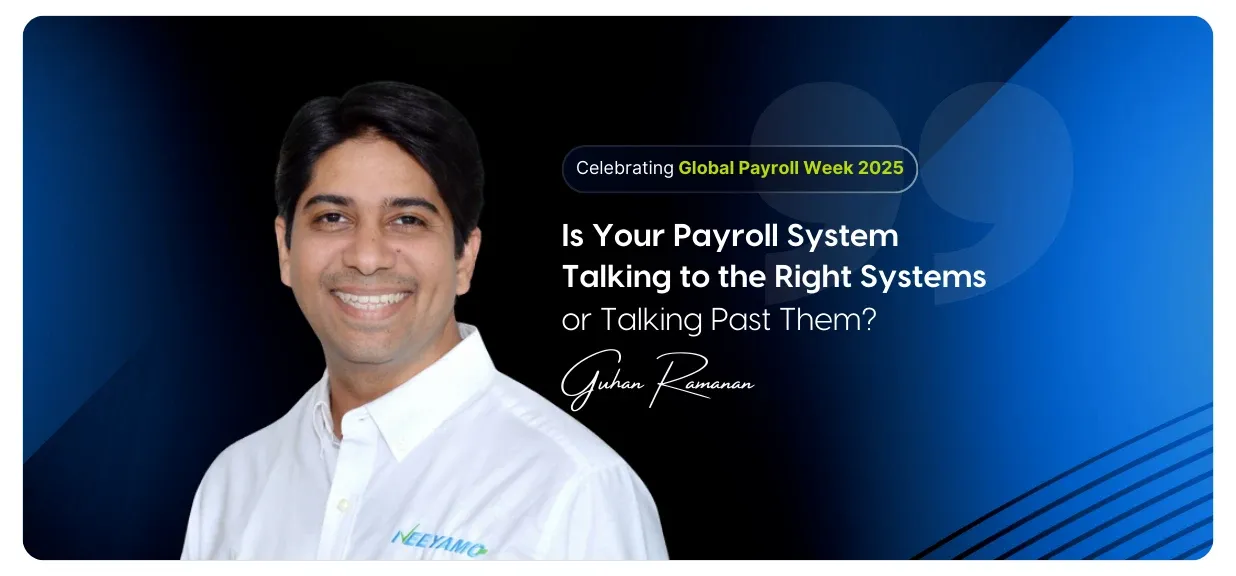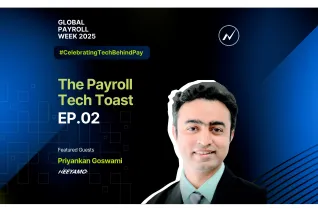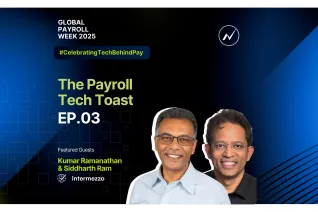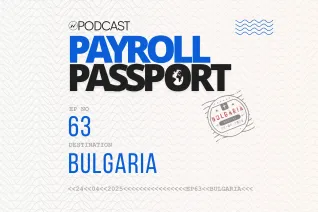Is Your Payroll System Talking to the Right Systems or Talking Past Them?

By Guhan, Co-founder & President – Customer Success, Neeyamo
Let’s say: It’s payday, but your finance and HR teams are frantically troubleshooting payroll errors traced back to mismatched data, manual entries, or outdated systems. Employees are frustrated, compliance risks are mounting, and leadership is left wondering why payroll still feels so fragmented in an era of automation.
It’s not a small problem, especially when labor costs consume 70.4% of business expenses (as of late 2024). Every payroll error magnifies financial and operational risks, turning what should be a moment of employee trust into a business vulnerability.
This isn’t just a technology problem, it’s a business risk.
The real question is: Are your systems working together, or are they speaking different languages?
Why Integration Is No Longer Optional
Payroll isn’t just about getting people paid, it sits at the core of employee experience, regulatory compliance, and business efficiency. When systems don’t talk to each other, the ripple effects are felt across your entire organization. Here’s why seamless integration is now a strategic imperative:
-
Employee Trust and Experience: Payroll accuracy is foundational to employee satisfaction and trust. A single missed payment or miscalculation can erode morale and drive talent elsewhere. In today’s competitive market, employees expect transparency, timely payments, and easy access to their payroll data, none of which are possible without seamless system integration
- Legal and Financial Health: Payroll is at the intersection of finance, HR, and compliance. With regulations evolving rapidly across jurisdictions, manual processes or disconnected systems can lead to costly compliance violations and penalties. Integrated payroll solutions automate compliance checks, maintain audit trails, and keep your business aligned with the latest tax and labor laws
- Operational Efficiency: Disconnected payroll systems mean duplicated data entry, manual reconciliations, and hours lost to error correction. Integration with HRIS, time and attendance, and accounting platforms eliminates silos, reduces manual work, and ensures real-time data accuracy freeing your teams to focus on strategic initiatives instead of firefighting
ALSO READ | Data Migration and Integration: Best Practices in HR Processes
Five Practices that Drive Seamless Payroll Integration
- Regular Audits
How do you proactively catch issues before they become costly mistakes?
Conduct scheduled audits across systems to spot data mismatches, broken integrations, or outdated configurations. Regular checks help ensure your payroll engine runs smoothly and catches errors early, before they snowball into compliance violations or employee dissatisfaction. - Maintain Accurate Records
How confident are you that your employee data is consistent across platforms?
Data integrity is non-negotiable. Integrated systems reduce the risk of conflicting information by ensuring that any updates, whether in HRIS, benefits, or time tracking, are reflected across all connected systems in real time. - Leverage Technology Wisely
How adaptable is your current payroll setup to scale, automate, and stay compliant?
Modern payroll demands more than spreadsheets and point solutions. Use technology that supports seamless integrations across your HRIS, time, accounting, and finance systems and that evolves with changing business needs and regulations. - Clear Communication
How aligned are your payroll, HR, finance, and IT teams on shared goals and data standards?
Cross-functional collaboration is key. Establish common protocols, hold regular alignment meetings, and ensure every team understands how their inputs affect payroll outcomes. Good integration isn’t just technical, it’s organizational. - Stay Abreast of Compliance
How do you ensure your payroll process stays in step with local and global regulations?
With laws and tax codes constantly evolving, your systems must do more than store data; they should support compliance. Use platforms with real-time regulatory updates, audit trails, and built-in alerts to stay ahead of risks and reduce manual tracking.
Where Things Go Wrong
- Neglecting Data Input Verification: Inaccurate or incomplete data at the source leads to payroll errors downstream. Reliable data gathering and validation are critical.
- Disregarding Regulatory Updates: Failing to keep up with new laws can result in non-compliance. Automated payroll solutions with built-in compliance tools are essential.
- Relying Solely on Manual Processes: Manual payroll is slow, error-prone, and unsustainable for growing organizations. Integration and automation are now baseline requirements.
- Underestimating Compliance Complexity: Global payroll means navigating a maze of local laws, currencies, and reporting standards. Effective technology is your best defense.
- Failing to Invest in Training: Payroll and HR teams must be data-literate and understand the systems they use. Ongoing training is vital for maximizing the benefits of integration
Turning Payroll Complexity Into Clarity
Managing global payroll shouldn’t be a constant battle with disconnected systems, manual processes, and compliance uncertainty. That’s why Neeyamo’s solutions are built to help you:
- Keep systems in sync with real-time, bi-directional data flows between HRIS, time tracking, finance, and benefits platforms reducing silos and manual work.
- Navigate compliance more easily with tools that assist with local and international requirements, offering continuous updates and supporting auditability through detailed, transparent records, while keeping you in control of complex cases.
- Scale confidently with systems designed to manage the realities of multi-country compliance, cross-border payments, and a globally diverse workforce.
- Earn employee trust through accurate, transparent, and timely payroll processing that creates a better experience at every step.
By connecting critical payroll systems around the world, organizations can reduce risk, work more efficiently, and build a workplace where employees feel valued and supported.
Payroll shouldn’t slow your growth; it should power it.
ALSO READ | Why Global Payroll Compliance Should Be on Every CXO’s Radar
A Final Thought
If your payroll system isn’t fully integrated, it’s not just efficiency you’re losing, it’s insight, agility, and control. Disconnected systems can’t deliver the visibility or responsiveness that today’s businesses need.
So ask yourself:
Is your payroll system powering your business or holding it back?
If the answer isn’t clear, it’s time to re-evaluate.
Neeyamo helps organizations move beyond transactional payroll to a truly connected model, one that enables smarter decisions, reduces risk, and turns payroll into a strategic advantage. To know more, reach out to us at irene.jones@neeyamo.com
Latest Resources
Stay informed with latest updates
If you're curious and have a thirst for knowledge pertaining to the HR, payroll, and EOR universe, don't miss out on subscribing to our resources.















